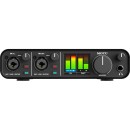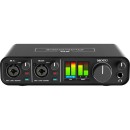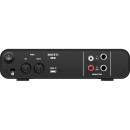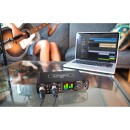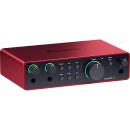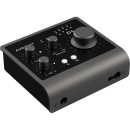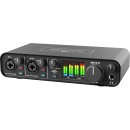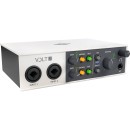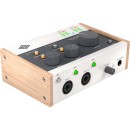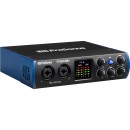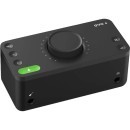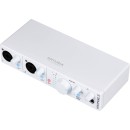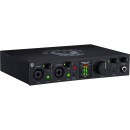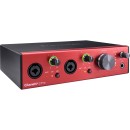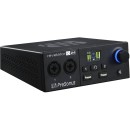MOTU M2 USB-C Audio/MIDI Interface: A Comprehensive Review
- 2-in/2-out USB-C audio interface
- 24-bit/192 kHz audio resolution
- High-quality ESS Sabre32 Ultra DAC technology
- Ultra-low latency performance
- MIDI input and output
- Loopback functionality for live streaming and podcasting
- Direct monitoring with hardware knobs
- Two mic/line/hi-Z combo inputs with preamps
- RCA stereo outputs
- Headphone output with independent volume control
- Full-color LCD display for metering and monitoring
- Bus-powered via USB-C connection
- Includes software bundle with DAWs and virtual instruments
Detailed Specifications and Analysis
The MOTU M2 USB-C Audio/MIDI Interface is a high-quality, compact audio interface designed for musicians, podcasters, and content creators. With its advanced ESS Sabre32 Ultra™ DAC technology, the M2 delivers pristine audio quality with a dynamic range of 120dB. This ensures that recordings and playback are crystal clear, making it an excellent choice for professional and home studios alike.
Featuring two mic/line/instrument inputs with high-gain, low-noise preamps, the M2 allows for versatile recording options. The interface also includes MIDI in/out ports, enabling seamless integration with MIDI controllers and other gear. With its zero-latency hardware monitoring and loopback functionality, users can effortlessly manage their audio routing for live streaming or recording.
The MOTU M2 is designed with user-friendly features such as a full-color LCD screen that provides detailed metering for all inputs and outputs. Its robust build quality and bus-powered operation via USB-C make it both durable and portable. Whether you're recording vocals, instruments, or MIDI data, the MOTU M2 offers a reliable and high-fidelity solution for all your audio needs.
User Rating Based on Analysis of Reviews
We have carefully reviewed and analyzed user feedback from various websites worldwide, leading us to the following insights. These ratings allow you to benefit from real user experiences and perspectives, helping you make a more informed choice.
Purchase Value
85% of users expressed satisfaction with the purchase value of the MOTU M2 Audio Interface, highlighting its competitive pricing compared to other interfaces with similar features. Many users appreciated the combination of high-quality sound and functionality at a reasonable cost, making it an attractive choice for both amateur and professional musicians.
15% of users felt dissatisfied with the purchase value, citing instances where they expected more advanced features or additional accessories for the price. Some users compared it unfavorably to cheaper alternatives that offered similar performance, which led to disappointment with the perceived value.
Sound Quality
90% of users praised the sound quality of the MOTU M2, noting its clear and crisp audio output and excellent preamps. Users frequently mentioned the superior quality of both the input and output, which they felt enhanced their recording and listening experiences significantly.
10% of users expressed dissatisfaction with the sound quality, often due to specific technical issues or personal preferences for different audio signatures. Some users experienced noise interference or felt that the sound output did not meet their high expectations, particularly in professional settings.
Build Quality
88% of users were satisfied with the build quality of the MOTU M2, appreciating its sturdy construction and durable materials. Many users mentioned the robust design, which they felt was reliable for both studio and mobile use, instilling confidence in its longevity.
12% of users were dissatisfied with the build quality, citing issues such as loose knobs or connectors. Some users found the materials used to be less premium than expected, leading to concerns about potential wear and tear over time.
Ease of Use
83% of users found the MOTU M2 easy to use, highlighting its straightforward setup process and intuitive interface. Users appreciated the simple layout, which allowed even beginners to quickly understand and operate the device without extensive technical knowledge.
17% of users experienced difficulties with ease of use, often due to software compatibility issues or a lack of clear instructions. Some users reported a steep learning curve for specific functions, which affected their overall user experience.
Driver Stability
80% of users were satisfied with the stability of the MOTU M2 drivers, noting few crashes or disconnections during use. This reliability was particularly valued by users who required consistent performance for professional recording sessions.
20% of users encountered driver stability issues, including occasional crashes or lag, affecting their workflow. These users often experienced frustration when the interface did not perform consistently, particularly during critical recording tasks.
Customer Support
75% of users had positive experiences with MOTU's customer support, appreciating the responsiveness and helpfulness of the support team. Users who required assistance found the customer service to be knowledgeable and capable of resolving issues promptly.
25% of users were dissatisfied with customer support, citing delays in response times or unhelpful interactions. Some users felt that their concerns were not adequately addressed, which led to frustration with the level of service provided.
Portability
85% of users praised the portability of the MOTU M2, mentioning its compact size and lightweight design as ideal for on-the-go recording. Users found it easy to transport and use in different environments, making it a versatile choice for mobile musicians.
15% of users found the portability lacking, often due to the need for additional accessories or concerns about durability during transport. Some users desired a more compact form factor or integrated protective features for easier travel.
Latency Performance
87% of users were satisfied with the latency performance of the MOTU M2, noting minimal delay during recording and playback. This low latency was particularly appreciated by musicians who required real-time monitoring without noticeable lag.
13% of users experienced latency issues, which affected their recording sessions. Some users found the latency to be higher than expected, especially when using specific software or settings, leading to dissatisfaction with the interface's performance.
Compatibility
82% of users highlighted the compatibility of the MOTU M2 with various operating systems and digital audio workstations, allowing seamless integration into existing setups. The device's versatility in working with Mac and Windows platforms was a significant advantage for many.
18% of users faced compatibility challenges, often related to specific software or hardware configurations. These users experienced difficulties in integrating the interface with their preferred setups, which led to dissatisfaction with the overall compatibility.
Input/Output Options
80% of users were satisfied with the input and output options offered by the MOTU M2, appreciating the variety and quality of connections available. Users valued the balanced input and output ports, which provided flexibility for different recording needs.
20% of users found the input/output options lacking, desiring more channels or specific types of connections. Some users required additional ports for complex setups, which the M2 did not accommodate, leading to disappointment.
Aesthetics
88% of users found the aesthetics of the MOTU M2 appealing, praising its sleek design and professional look. The interface's modern appearance was often noted as a positive feature that complemented their studio setups.
12% of users were dissatisfied with the aesthetics, often preferring a different style or color scheme. Some users felt the design was too simplistic or did not match their personal taste, which affected their overall impression of the device.
Installation Process
84% of users found the installation process for the MOTU M2 straightforward and hassle-free, with clear instructions and minimal setup time. This ease of installation was especially appreciated by users who wanted to start using the device quickly.
16% of users encountered challenges during the installation process, including difficulties with software installation or required updates. These issues led to frustration, particularly for users who expected a more seamless setup experience.
Software Features
78% of users were satisfied with the software features included with the MOTU M2, appreciating the basic tools and functionality provided for recording and editing. Users found the software adequate for most of their needs, especially when starting out.
22% of users found the software features lacking, desiring more advanced options or additional plug-ins. Some users felt the software was limited compared to other interfaces, which affected their ability to fully utilize the device's potential.
Durability
86% of users were satisfied with the durability of the MOTU M2, noting its solid construction and resistance to wear over time. Users appreciated the robust materials that provided confidence in the device's long-term reliability.
14% of users were concerned about the durability, often due to issues with specific components like knobs or buttons. Some users experienced wear and tear sooner than expected, which raised doubts about the interface's longevity.
Versatility
83% of users praised the versatility of the MOTU M2, citing its ability to handle various recording scenarios and environments. Users valued its adaptability for different music genres and recording setups, making it a flexible choice for many applications.
17% of users found the versatility limited, often due to specific requirements that the M2 could not meet. Some users needed more features or customization options for particular projects, which the device did not provide, leading to dissatisfaction.
Control Features
79% of users were satisfied with the control features of the MOTU M2, appreciating the accessible and functional design of the controls. Users found the controls intuitive and effective for managing their audio settings during use.
21% of users were dissatisfied with the control features, often finding them too basic or lacking in advanced options. Some users desired more precise or customizable controls to better suit their specific audio needs.
Power Options
82% of users appreciated the power options of the MOTU M2, noting the convenience of USB power for portability and ease of use. Users valued the ability to operate the device without the need for additional power sources, enhancing its mobility.
18% of users found the power options limiting, often preferring alternative power solutions for specific setups. Some users experienced issues with power stability, particularly when using the interface in environments with variable power availability.
Expandability
77% of users were satisfied with the expandability of the MOTU M2, finding it sufficient for basic studio setups and small-scale projects. Users appreciated the ability to connect additional devices as needed within its scope.
23% of users found the expandability insufficient, particularly for larger or more complex audio setups. Some users desired more connectivity options or the ability to chain multiple interfaces together, which the M2 did not support.
Pedal Integration
70% of users appreciated the basic pedal integration capabilities of the MOTU M2, finding it suitable for simple setups and straightforward use. Users valued the available connections for integrating pedals into their signal chain.
30% of users were dissatisfied with the pedal integration options, often requiring more advanced features or specific connections. Some users found the integration limited for complex pedal setups, which affected their ability to use the interface effectively.
Visual Display
89% of users were highly satisfied with the visual display of the MOTU M2, praising its clear and informative readouts. Users found the display helpful for monitoring levels and making quick adjustments during recording sessions.
11% of users found the visual display lacking, often desiring more detailed information or customizable display options. Some users felt the display could be improved for better visibility in different lighting conditions.
Overall Satisfaction
87% of users reported overall satisfaction with the MOTU M2, citing its combination of high-quality sound, build, and functionality as major strengths. Users appreciated its value for money and suitability for a wide range of applications, making it a popular choice among audio enthusiasts.
13% of users expressed overall dissatisfaction, often due to specific unmet expectations or technical issues. Some users encountered compatibility or performance problems that detracted from their experience, leading to disappointment with the interface.
In the following sections, we will delve into the detailed specifications of the MOTU M2 USB-C Audio/MIDI Interface. Our comprehensive review will cover both the advantages and disadvantages of this product, offering you a thorough understanding to help you decide if it meets your needs.
Pros:
- Excellent sound quality with ESS Sabre32 Ultra DAC technology.
- Low latency performance for real-time monitoring.
- Sturdy and compact build, suitable for mobile use.
- USB-C connectivity ensures fast data transfer.
- Clear and detailed LCD metering.
Cons:
- Limited to 2 inputs and 2 outputs.
- No onboard DSP effects.
- Some users may find the software bundle lacking.
- Requires a USB-C port for optimal performance, which may not be available on all computers.
General
| Channels of I/O | Analog: 2 Inputs / 2 Outputs |
|---|---|
| Maximum Sampling Rate | 192 kHz / 24-Bit |
| Number of Microphone Inputs | 2 Preamps |
| Built-In Microphone | |
| Input Level Adjustment | 2x Knob |
| Expansion Slots |
The specifications for the MOTU M2 USB-C Audio/MIDI Interface highlight its capabilities, making it a versatile tool for audio production.Show More
The Channels of I/O refers to the number of inputs and outputs available for audio signals. With 2 inputs and 2 outputs, users can connect various audio sources, such as microphones or instruments, and send the audio to speakers or recording software. This configuration is ideal for basic recording setups, ensuring a straightforward workflow for musicians and producers.
The Maximum Sampling Rate indicates the highest quality of audio that the interface can process, measured in kilohertz (kHz) and bit depth. With a maximum sampling rate of 192 kHz and 24-bit depth, the M2 ensures high-resolution audio capture, providing clarity and detail in recordings. This capability is particularly beneficial for professional audio applications, allowing for intricate sound designs and dynamic range.
The Number of Microphone Inputs specifies how many microphones can be directly connected to the interface. The M2 features 2 preamps, allowing for the simultaneous connection of two microphones. This is essential for recording duets, interviews, or multiple sound sources at once, providing flexibility and convenience during sessions.
The Built-In Microphone indicates whether the interface has an integrated microphone for voice recording. The M2 does not include a built-in microphone, which means users will need to provide their own microphones for recording. This allows for greater customization of audio quality, as users can select the microphones that best suit their needs.
The Input Level Adjustment feature refers to the ability to control the gain or sensitivity of the input signals. With 2 knobs for input level adjustment, users can easily fine-tune the sound levels of connected microphones or instruments, ensuring optimal recording levels and preventing distortion or clipping.
Lastly, the Expansion Slots indicate whether the device supports additional hardware for expanding its capabilities. The M2 does not have expansion slots, meaning it is a self-contained unit without options for upgrading or adding external modules. This design simplifies the interface, making it user-friendly for those who prefer a straightforward and efficient audio setup.
Signal Processing
| Pad | |
|---|---|
| Gain/Trim Range | Mic Inputs: 0 dB to +60 dB Line/Hi-Z Inputs: 0 dB to +57 dB |
| High-Pass Filter | |
| Solo/Mute |
The specifications of the MOTU M2 USB-C Audio/MIDI Interface provide valuable insights into its functionality and versatility. Show More
Starting with the Pad feature, its absence indicates that the device does not have a built-in attenuation option for incoming signals. This means that users will need to ensure that their input levels are adequately managed externally to prevent distortion or clipping.
The Gain/Trim Range is crucial for determining how much amplification can be applied to incoming signals. For mic inputs, the range from 0 dB to +60 dB allows for a wide range of signal levels, accommodating everything from quiet vocals to louder sound sources. Similarly, the line/Hi-Z inputs have a range from 0 dB to +57 dB, making it suitable for various instruments and line-level devices. The ability to adjust gain within these ranges ensures that users can achieve optimal recording levels without compromising audio quality.
The High-Pass Filter feature, which is not present in this model, would typically allow users to eliminate low-frequency noise and rumble from their recordings. Without this filter, users may need to address low-frequency issues during post-production, which can be less efficient.
Lastly, the lack of Solo/Mute functionality means that users cannot isolate or silence individual tracks during monitoring. This might require additional management through software or external mixing equipment to control the audio mix effectively during recording sessions. Overall, these specifications highlight the MOTU M2's focus on providing high-quality audio input options while prompting users to manage specific aspects of their recording process externally.
Connectivity
| Analog Audio I/O | 2x Combo XLR-1/4" TRS Balanced/Unbalanced Mic/Line/Hi-Z Input 1x 1/4" TRS Unbalanced Headphone Output 2x 1/4" TRS Balanced Line Output (DC-Coupled) 2x RCA TS Unbalanced Line Output |
|---|---|
| Phantom Power | 48 V, Selectable On/Off (Selectable on Individual Inputs) |
| Digital Audio I/O | |
| Host Connection | 1x USB-C |
| Host Connection Protocol | USB 2.0 |
| USB (Non-Host) | |
| Sync I/O | |
| Network I/O | |
| MIDI I/O | 1x DIN 5-Pin Input 1x DIN 5-Pin Output |
The MOTU M2 USB-C Audio/MIDI Interface offers a comprehensive range of specifications designed to cater to various audio recording and playback needs. Show More
Starting with the Analog Audio I/O, the interface features two combo XLR-1/4" TRS inputs that can accommodate balanced or unbalanced microphones, line-level signals, or high-impedance instruments. This flexibility allows users to connect a wide variety of audio sources. Additionally, it includes a 1/4" TRS unbalanced headphone output for monitoring, as well as two balanced line outputs and two unbalanced RCA line outputs. The availability of both balanced and unbalanced connections enhances compatibility with different audio equipment and reduces noise in the signal path.
The Phantom Power specification provides 48V power, which is crucial for operating condenser microphones. This feature can be toggled on or off for each individual input, giving users control over their setup and ensuring that only the necessary channels receive phantom power, thus avoiding potential damage to equipment that does not require it.
In terms of Digital Audio I/O, this interface does not include any digital audio connections, which may limit options for those looking to integrate with digital audio networks or other digital devices. However, it does offer a robust Host Connection via a USB-C port that follows the USB 2.0 protocol, allowing for high-speed data transfer to and from the computer.
When considering MIDI I/O, the MOTU M2 provides one DIN 5-Pin input and one output. This is essential for connecting MIDI devices, such as keyboards or controllers, enabling users to integrate MIDI functionality into their recordings or performances.
Overall, the specifications of the MOTU M2 USB-C Audio/MIDI Interface reflect a well-rounded tool designed for both amateur and professional audio applications, providing versatility in connectivity, monitoring, and MIDI integration.
Performance
| Frequency Response | Mic Inputs: 20 Hz to 20 kHz +0/-0.1 dB Line, Hi-Z Inputs: 20 Hz to 20 kHz ±0.15 dB Line Outputs: 20 Hz to 20 kHz +0/-0.1 dB |
|---|---|
| Maximum Input Level | Mic Inputs: +10 dBu (Min Gain) Line/Hi-Z Inputs: +16 dBu (Min Gain) |
| Maximum Output Level | Line Outputs: +16 dBu (Balanced) Line Outputs: +9.5 dBu (Unbalanced) Headphone Outputs: +12.5 dBu |
| Impedance | Mic Inputs: 2.65 Kilohms Line Inputs: 2 Megohms Hi-Z Inputs: 1 Megohm Line Outputs: 100 Ohms |
| Dynamic Range | Mic Inputs: 115 dBA Line/Hi-Z Inputs: 114 dBA 1/4" Line/Monitor Outputs: 120 dBA RCA Line Outputs: 119 dBA Headphone Outputs: 115 dBA |
| THD+N | Mic Inputs: < -97 dB / < 0.0014% Line/Hi-Z Inputs: < -100 dB / < 0.001% 1/4" Line/Monitor Outputs: < -110 dB / < 0.00032% RCA Line Outputs: < -105 dB / < 0.00056% Headphone Outputs: < -110 dB / < 0.0003% |
| EIN | Mic Inputs: -129 dB A-Weighted (150-Ohm Source, Max Gain) |
The MOTU M2 USB-C Audio/MIDI Interface boasts impressive specifications that enhance its performance and usability in professional audio environments. Show More
Frequency Response indicates the range of frequencies the device can handle and how accurately it reproduces them. The mic inputs and line/Hi-Z inputs have a frequency response of 20 Hz to 20 kHz, which covers the full range of human hearing. This ensures that vocals and instruments are captured with clarity and precision. The minimal deviation in response (+0/-0.1 dB for mic and line outputs) suggests that the M2 maintains a uniform response across its operating range, making it ideal for high-fidelity recordings.
Maximum Input Level measures the highest signal strength the interface can accept without distortion. For example, the +10 dBu for mic inputs and +16 dBu for line/Hi-Z inputs indicate that the M2 can handle a robust signal without compromising audio quality. This feature is crucial for capturing loud sound sources, ensuring they are recorded without clipping.
Maximum Output Level details the peak output levels the device can provide to connected gear. The balanced line outputs at +16 dBu ensure strong signal transmission to speakers or mixers, while the headphone outputs at +12.5 dBu deliver ample power for monitoring. High output levels are essential for driving studio monitors and headphones effectively.
Impedance affects how the device interacts with other equipment in the signal chain. The mic inputs have a relatively low impedance of 2.65 Kilohms, which is suitable for most microphones, while the line inputs have a high impedance of 2 Megohms, allowing for better compatibility with various signal sources. Proper impedance matching can enhance signal quality and reduce noise.
Dynamic Range measures the difference between the quietest and loudest sounds the device can process without distortion. The M2’s dynamic range of up to 120 dBA for 1/4" line/monitor outputs indicates that it can handle a wide range of audio levels, making it suitable for both subtle and powerful performances.
THD+N (Total Harmonic Distortion + Noise) represents the level of unwanted distortion and noise added to the audio signal. With values less than -110 dB for various outputs, the M2 minimizes any interference in the audio path, preserving the integrity of the sound. Low distortion is vital for achieving clear and accurate playback.
Finally, EIN (Equivalent Input Noise) measures the inherent noise level of the device when no signal is present. The M2's EIN of -129 dB, tested with a 150-ohm source, indicates extremely low noise levels, ensuring that quiet sounds are captured with fidelity and without unwanted background noise. This feature is particularly important for capturing soft vocal performances or delicate instruments.
Overall, these specifications make the MOTU M2 an excellent choice for both recording and playback in professional audio settings, offering high-quality performance across a range of applications.
Digital Audio
| Sample Rates | Up to 192 kHz |
|---|---|
| Sample Rate Conversion | |
| Bit Depths | 24-Bit |
| Latency | Zero-Latency Direct Monitoring2.5 ms at 96 kHz (Dependent on Buffer Size, Input to Output) |
| Sync Sources | Internal |
The MOTU M2 USB-C Audio/MIDI Interface boasts impressive specifications that cater to the needs of audio professionals and enthusiasts alike. Show More
Sample Rates refers to the frequency at which audio is recorded or played back, measured in kilohertz (kHz). The M2 supports sample rates of up to 192 kHz, allowing for high-fidelity audio reproduction and capturing intricate details in recordings. Higher sample rates can enhance clarity and provide a more accurate representation of the original audio source.
Sample Rate Conversion indicates whether the device can adjust the sample rate of incoming audio signals. The M2 does not feature sample rate conversion, which means it will operate at the designated sample rate without any internal adjustments. This can be beneficial for maintaining audio integrity but may require external solutions if different sample rates are involved in your setup.
Bit Depths refers to the number of bits used to represent each audio sample. The M2 operates at a 24-bit depth, which significantly improves dynamic range and allows for more subtle nuances in audio recordings compared to lower bit depths. This leads to better overall sound quality and provides greater headroom for processing.
Latency is the delay between the input and output of audio signals, which can be crucial for live monitoring and recording. The M2 features Zero-Latency Direct Monitoring, with a minimal latency of 2.5 ms at 96 kHz, depending on the buffer size. This allows musicians and engineers to hear their input signals in real-time without distracting delays, enhancing performance and recording accuracy.
Sync Sources indicates the reference signal used for timing and synchronization in audio playback and recording. The M2 relies on an internal sync source, ensuring that all audio processes are tightly controlled and aligned without needing external synchronization. This creates a stable environment for audio production, contributing to professional-quality results.
Audio Storage & Playback
| Memory Card Slot |
|---|
The MOTU M2 USB-C Audio/MIDI Interface is designed for high-quality audio recording and MIDI functionality without the need for a memory card slot. This feature indicates that the device does not support external storage for saving audio files or settings directly on the interface. Instead, users can record and manage their audio through a connected computer or other devices, which is common in modern audio interfaces. Show More
The absence of a memory card slot simplifies the design and reduces potential points of failure, making the M2 an efficient and reliable choice for musicians and audio professionals. Users will need to rely on their computer’s storage capabilities to manage audio files, which can be advantageous as it allows for more extensive storage options and easier integration with digital audio workstations (DAWs). Overall, while some may prefer a built-in memory solution, the M2’s design focuses on delivering professional audio quality and straightforward connectivity.
Compatibility
| OS Compatibility | macOS 10.11 or Later Windows 7 or Later 9 or Later |
|---|---|
| Processor Requirement | Mac: 1 GHz Intel PC: 1 GHz Intel Pentium |
| RAM Requirements | 2 GB, 4 GB Recommended |
| Required Hardware | Available USB 2.0 Port USB Cable (Included) |
| Internet Connection | Required for Software/Driver Download |
The OS Compatibility of the MOTU M2 USB-C Audio/MIDI Interface indicates the operating systems that can effectively run the device. It supports macOS versions from 10.11 and later, as well as Windows 7 and later. This ensures that users on modern operating systems can seamlessly integrate the interface into their audio production setups.Show More
The Processor Requirement specifies the minimum CPU specifications necessary for optimal performance. For Mac users, a 1 GHz Intel processor is required, while PC users need at least a 1 GHz Intel Pentium processor. Having a compatible processor ensures that the audio interface can handle tasks like digital audio processing without lag or interruptions.
The RAM Requirements highlight the memory needed to run the device efficiently. A minimum of 2 GB of RAM is required, though 4 GB is recommended for better performance. Adequate RAM is crucial for audio applications as it allows for smoother multitasking and reduces the risk of audio dropouts during recording and playback.
The Required Hardware section notes that users must have an available USB 2.0 port and includes a USB cable for connectivity. This ensures that the interface can be easily connected to a computer for audio input and output without additional purchases.
Lastly, the Internet Connection requirement signifies the need for an internet connection to download necessary software or drivers. This is important for ensuring that the interface is up-to-date with the latest features and improvements, allowing users to maximize its capabilities.
Power
| Power Requirements | USB Bus Power |
|---|
The Power Requirements specification indicates how the MOTU M2 USB-C Audio/MIDI Interface receives its power. In this case, it operates using USB Bus Power, which means it draws power directly from the connected USB port on your computer or device. This feature is particularly convenient for users as it eliminates the need for an external power supply, allowing for a more streamlined and portable setup. Show More
Using USB Bus Power ensures that the interface can be easily powered on-the-go, making it ideal for musicians, podcasters, and content creators who travel or work in different locations. Additionally, since it relies on the power from the USB connection, it simplifies the setup process, allowing users to focus on their audio tasks without worrying about managing additional power sources. Overall, this specification enhances the usability and flexibility of the MOTU M2, making it an appealing choice for various audio applications.
Physical
| Anti-Theft Features | Kensington Security Slot |
|---|---|
| Dimensions | 7.5 x 4.25 x 1.75" / 19.1 x 10.79 x 4.45 cm (Chassis Only) |
| Weight | 1.4 lb / 0.6 kg |
The MOTU M2 USB-C Audio/MIDI Interface comes equipped with several specifications that enhance its usability, portability, and security. Show More
Starting with the **Anti-Theft Features**, the inclusion of a Kensington Security Slot provides users with the ability to secure their device against theft. This is particularly beneficial for professionals who may use the interface in various locations, such as studios or live venues, ensuring peace of mind while they focus on their work.
In terms of **Dimensions**, the MOTU M2 measures 7.5 x 4.25 x 1.75 inches (or 19.1 x 10.79 x 4.45 cm when considering the chassis only). These compact dimensions make it an excellent choice for those who require a portable audio solution that can easily fit into a bag or on a crowded desk without taking up excessive space.
The **Weight** of the device is also an important factor, coming in at just 1.4 lb (or 0.6 kg). This lightweight design enhances portability, making it easier for users to transport the interface to different locations without feeling burdened by additional weight. It's ideal for musicians, sound engineers, and content creators who are always on the move.
Overall, these specifications contribute to the overall functionality and convenience of the MOTU M2, making it a suitable choice for a wide range of audio applications.
Packaging Info
| Package Weight | 1.8 lb |
|---|---|
| Box Dimensions (LxWxH) | 10 x 7.45 x 2.75" |
The Package Weight of 1.8 lb indicates the total weight of the MOTU M2 USB-C Audio/MIDI Interface when packaged. This is important for users who need to consider shipping costs or transportability. A lighter package makes it easier for musicians and audio professionals to carry their gear to gigs or studio sessions without adding excessive weight to their equipment bags.Show More
The Box Dimensions of 10 x 7.45 x 2.75 inches refer to the physical size of the package containing the audio interface. These dimensions provide insight into how much space the device will occupy. A compact design is beneficial for users with limited workspace or those who need to store their gear in smaller setups. Understanding the box dimensions can help in planning for storage and portability, ensuring the interface fits seamlessly into your existing equipment collection.
Customer Images
Customer Questions
How do I install the MOTU M2 drivers on my computer?
To install the MOTU M2 drivers, visit the MOTU website, go to the 'Downloads' section, and select the MOTU M2. Download the latest driver for your operating system (Windows or macOS). Run the installer and follow the on-screen instructions to complete the installation.
Why is my computer not recognizing the MOTU M2?
Ensure that the MOTU M2 is properly connected to your computer via the USB-C cable. Try using a different USB port or cable if necessary. Make sure you have installed the latest drivers from the MOTU website. Restart your computer and the MOTU M2 to see if it resolves the issue.
How do I set up the MOTU M2 with my DAW?
Open your DAW and go to the audio settings or preferences. Select the MOTU M2 as your audio input and output device. Ensure that the sample rate and buffer size are set appropriately for your project. Save the settings and restart the DAW if necessary.
Why am I experiencing latency issues with the MOTU M2?
Latency can be reduced by adjusting the buffer size in your DAW's audio settings. Lower the buffer size to reduce latency, but be aware that this may increase CPU usage. Ensure that your computer meets the system requirements for the MOTU M2 and that there are no other resource-intensive applications running.
How do I update the firmware on my MOTU M2?
Visit the MOTU website and navigate to the 'Downloads' section. Download the latest firmware update for the M2. Follow the provided instructions to install the firmware update, which typically involves running a utility and following on-screen prompts.
Why is there no sound coming from my MOTU M2?
Check that your speakers or headphones are properly connected to the MOTU M2. Ensure that the input and output levels are not muted or set too low. Verify that the MOTU M2 is selected as the audio output device in your computer's sound settings and in your DAW.
How do I connect MIDI devices to the MOTU M2?
Connect your MIDI device to the MIDI IN or MIDI OUT ports on the MOTU M2 using a standard MIDI cable. In your DAW, go to the MIDI settings and select the MOTU M2 as the MIDI input and/or output device. Configure your MIDI tracks accordingly.
Can I use the MOTU M2 with an iPad or iPhone?
Yes, the MOTU M2 can be used with an iPad or iPhone using a USB-C to Lightning adapter (for iPhone) or a USB-C cable (for iPad Pro). Ensure that you have an appropriate powered USB hub if needed, as the iPad or iPhone may not provide sufficient power for the MOTU M2.
Why is my microphone not being detected by the MOTU M2?
Ensure that your microphone is properly connected to one of the combo XLR/TRS inputs on the MOTU M2. Make sure that phantom power (48V) is enabled if you are using a condenser microphone. Check the input gain levels and adjust them as necessary.
How do I use the loopback feature on the MOTU M2?
To use the loopback feature, open your DAW and go to the audio input settings. Select the loopback channels provided by the MOTU M2 as the input source. This will allow you to record system audio or audio from other applications directly into your DAW.
Comparison
← SWIPE THE TABLE TO SEE MORE →
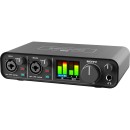
MOTU M2 |
VS | |||||||||||
|---|---|---|---|---|---|---|---|---|---|---|---|---|
| Analog: 2 Inputs / 2 Outputs |
Channels of I/O |
Analog: 2 Inputs / 2 Outputs at 192 kHz |
Analog: 2 Inputs / 2 Outputs at 96 kHz |
Analog: 4 Inputs / 4 Outputs |
Analog: 2 Inputs / 2 Outputs |
Analog: 2 Inputs / 2 Outputs |
Analog: 2 Inputs / 2 Outputs at 192 kHz |
Analog: 2 Inputs / 2 Outputs at 96 kHz |
Analog: 2 Inputs / 2 Outputs |
Analog / Digital: 2 Inputs / 2 Outputs |
Analog: 2 Inputs / 4 Outputs Digital: 8 Inputs / 0 Outputs |
Analog: 2 Inputs / 4 Outputs |
| 192 kHz / 24-Bit | Maximum Sampling Rate | 192 kHz / 24-Bit | 96 kHz / 24-Bit | 192 kHz / 24-Bit | 192 kHz / 24-Bit | 192 kHz / 24-Bit | 192 kHz / 24-Bit | 96 kHz / 24-Bit | 192 kHz / 24-Bit | 192 kHz / 24-Bit | 192 kHz / 24-Bit | 96 kHz / 24-Bit |
| 2 Preamps | Number of Microphone Inputs | 2 | 1 Preamp | 2 Preamps | 2 Preamps | 2 Preamps | 2 Preamps | 2 Preamps | 2 Preamps | 2 Preamps | 2 Preamps | 2 Preamps |
| 2x Combo XLR-1/4" TRS Balanced/Unbalanced Mic/Line/Hi-Z Input 1x 1/4" TRS Unbalanced Headphone Output 2x 1/4" TRS Balanced Line Output (DC-Coupled) 2x RCA TS Unbalanced Line Output |
Analog Audio I/O |
2x XLR 3-Pin Balanced Mic Input 2x 1/4" TRS Balanced/Unbalanced Line/Hi-Z Input (Front Panel) 2x 1/4" TRS Balanced Monitor Output 1x 1/4" TRS Headphone Output (Front Panel) |
1x Combo XLR-1/4" TRS Balanced Mic/Line Input 1x 1/4" TRS Unbalanced Hi-Z Input (Front Panel) 2x 1/4" TRS Balanced Monitor Output 1x 1/4" TRS Unbalanced Headphone Output (Front Panel) 1x 1/8" / 3.5 mm TRS Unbalanced Headphone Output (Front Panel) |
2x Combo XLR-1/4" TRS Balanced/Unbalanced Mic/Line/Hi-Z Input 2x 1/4" TRS Balanced Line Input 1x 1/4" TRS Unbalanced Headphone Output 4x 1/4" TRS Balanced Line Output (DC-Coupled) 4x RCA TS Unbalanced Line Output |
2x Combo XLR-1/4" TRS Balanced/Unbalanced Mic/Line/Hi-Z Input (Front Panel) 2x 1/4" TRS Balanced Monitor Output 1x 1/4" TRS Unbalanced Headphone Output (Front Panel) |
2x Combo XLR-1/4" TRS Balanced/Unbalanced Mic/Line/Hi-Z Input (Front Panel) 2x 1/4" TRS Balanced Monitor Output 1x 1/4" TRS Unbalanced Headphone Output (Front Panel) |
2x Combo XLR-1/4" TRS Balanced/Unbalanced Mic/Line/Hi-Z Input 2x 1/4" TRS Balanced Line/Monitor Output 1x 1/4" TRS Unbalanced Headphone Output |
2x Combo XLR-1/4" TRS Balanced Mic/Line Input 1x 1/4" TS Unbalanced Hi-Z Input 2x 1/4" TRS Balanced Monitor Output 1x 1/4" TRS Unbalanced Headphone Output |
2x Combo XLR-1/4" TRS Balanced/Unbalanced Mic/Line/Hi-Z Input (Front Panel) 2x 1/4" TRS Balanced Line Output 1x 1/4" TRS Unbalanced Headphone Output (Front Panel) |
2x Combo XLR-1/4" TRS Balanced/Unbalanced Mic/Line/Hi-Z Input (Front Panel) 2x 1/4" TRS Balanced Monitor Output 1x 1/4" TRS Unbalanced Headphone Output (Front Panel) |
2x Combo XLR-1/4" TRS Balanced/Unbalanced Mic/Line/Hi-Z Input (Front Panel) 4x 1/4" TRS Balanced Line/Monitor Output 1x 1/4" TRS Unbalanced Headphone Output (Front Panel) |
2x Combo XLR-1/4" TRS Balanced/Unbalanced Mic/Line/Hi-Z Input (Front Panel) 2x 1/4" TRS Balanced Monitor Output 1x 1/4" TRS Unbalanced Headphone Output |
| 1x USB-C | Host Connection | 1x USB-C | 1x USB-C | 1x USB-C | 1x USB-C | 1x USB-C | 1x USB-C (Class-Compliant) | 1x USB-C | 1x USB-C | 1x USB-C | 1x USB-C | 1x USB-C |
| macOS 10.11 or Later Windows 7 or Later 9 or Later |
OS Compatibility |
macOS Windows |
macOS 10.11.6 or Later macOS 11.1 or Later Windows 7 or Later 6 or Later iPadOS |
macOS 10.11 or Later Windows 7 or Later 9 or Later |
macOS 10.14 or Later Windows 10 (64-Bit Only) 14 or Later iPadOS 14 or Later |
macOS 10.14 or Later Windows 10 (64-Bit Only) 14 or Later iPadOS 14 or Later |
macOS 10.13 or Later (64-Bit Only) Windows 10 or Later (64-Bit Only) |
macOS 10.7.5 or Later Windows 7 or Later (32-/64-Bit) 6 or Later |
macOS Windows |
macOS Windows |
macOS 10.11 or Later macOS 11 Windows 7 or Later |
macOS 10.13 or Later (64-Bit Only) Windows 10 (64-Bit Only) 9.0.3 or Later |
| USB Bus Power | Power Requirements | USB Bus Power, USB Power Adapter (Not Included) | USB Bus Power | USB Bus Power | AC/DC Power Adapter (Not Included) or USB Bus Power | AC/DC Power Adapter (Not Included) or USB Bus Power | USB Bus Power | USB Bus Power | USB Bus Power | USB Bus Power | AC/DC Power Adapter (Included) or USB Bus Power | USB Bus Power |
